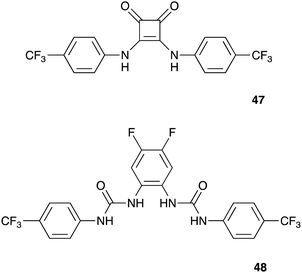2.B.88. The Squaramide/ortho-Phenylene bis-Urea-Anion Transporter (S/oPbU-AT) Family
Howe and Gale 2019 have explored the use of fatty acids to fuel chloride transport in vesicles. Upon addition of fatty acids such as oleic acid to a suspension of POPC vesicles, the fatty acid incorporates into the lipid bilayer. The carboxylic head group is able to diffuse across the bilayer, and so about 50% of the fatty acid diffuses across to the interior leaflet of the bilayer. Once there, some will deprotonate, and as the volume encapsulated by the vesicles is much smaller than the bulk solution, this results in a pH gradient (pHin < pHout). This electrochemical H+ gradient was harnessed by anionophores to drive HCl co-transport out of the vesicles using transporters such as 47 and 48 (see figure below), which are capable of transporting both protons and chloride, thus creating a chloride gradient. Additional pulses of fatty acid could be added to re-establish the pH gradient once it had dissipated, allowing further transport of chloride against the chloride gradient up to [Clin−] = 65 mM with [Clout−] = 100 mM. Adding fatty acid was 1400 times more efficient than using an external fuel such as NaOH to generate the same chloride gradient, illustrating the efficiency of using fatty acids as a fuel for transmembrane anion transport (Davis et al. 2020).
The combination of peptidometric oligoureas with α-helical peptides led to the formation of helical structures stabilized by a network of H-bonds. The designed molecules adopted well-defined helical structures that oligomerized into octameric transmembrane pores with anion transport activity by an antiport mechanism (X−/OH−) with the following selectivity: Cl− > NO3-> Br− > SCN− > I− > AcO− > F−. Due to their versatility and accessibility, peptides have also been applied as scaffolds for the arrangement of different molecular domains in supramolecular ion channels (Pérez-Pérez et al. 2025).
